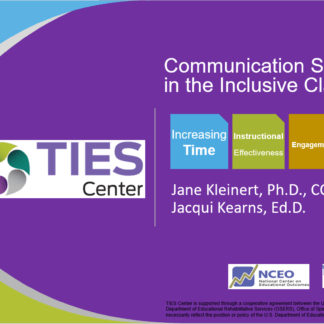Description
All children develop communicative competence – meaning that their communication is coherent and understood, reflects social/cultural norms, and may take a variety of forms (e.g. body language, facial expressions, spoken words, signs). Language is central to learning and expressing what has been learned.
Some learners, however, require specific communication supports (e.g. Augmentative Alternative Communication AAC) to advance their communication abilities. These learners may have difficulty processing and understanding language, using language to express a variety of intentions, or difficulty communicating within social and cultural norms. Communicating with coherence opens up new opportunities within one’s culture, family, and community. While communication and language development are essential, these students are often segregated into self-contained classes due to their communication status, and often without appropriate AAC to support them in the development of communication and language and the development of communication partners. Indeed, communication for these students is inter-personal – requiring the communication partner to understand and use the AAC device as well as the other communication forms used by the learner.
The inclusive class is the place with the most potential for supporting students to use all communicative modes, including AAC devices. There are many opportunities to practice communication with teachers, peers, and related service providers. Peers play an especially important role in supporting AAC users. Peer-mediated supports increases AAC use and social interaction among students with significant cognitive disabilities who use AAC. Encouraging peers to use AAC provides a wonderful opportunity to develop relationships, increase the communicative competence among peers to appropriately support the AAC user.


